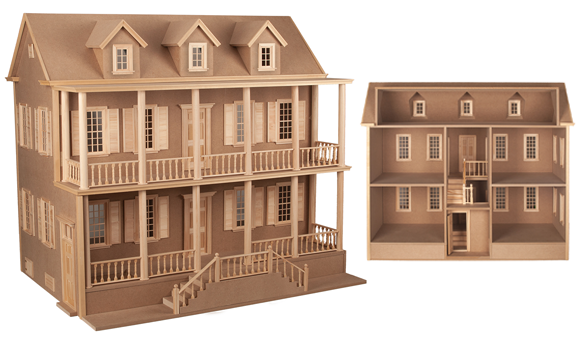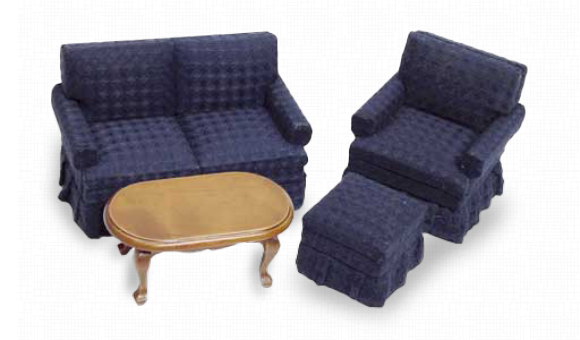The floors in dollhouses or room boxes can be real wood, carpet, tile, brick or paper. Flooring, no matter the type, enhances the interior of your dollhouse. If you're in the market for rugs, carpet, hardwood, or stone, you can view our collection of dollhouse flooring. Read on for installation tips!
Carpet
Always use a material that is in scale in both thickness and design to your dollhouse. Do not use real carpet samples or scraps that you have been saving as they are not in scale. The most widely used material is upholstery velvet or patterned upholstery fabrics. These materials can be attached to the floor with either a fabric glue or double sided carpet tape. Fabric glue is a special adhesive that will not bleed through the fabric.
When you do not want the carpet permanently attached, use double sided carpet tape around the edge of the floor and lay the carpet on top. Press down to attach to the carpet tape. If you wish to enhance your dollhouse with the look of wood, then the following suggestions should prove helpful. Wood flooring make beautiful backgrounds for handcrafted needlework and braided rugs.
Sheet Flooring
There are sheets of wood flooring that can be used to give your dollhouse or room box real wood floors. These sheets measure 11" x 17" and cover 187 square inch.
- DO NOT remove the wood from its paper backing.
- If the room or box is square or rectangular, measure both the width and length first, then cut a piece of flooring to these measurements.
- Since the flooring is thin, it can be cut with scissors.
- Iron with a dry iron (not steam) across the wood side of the flooring. This seals the paper backing to the wood.
- Because the backing is paper, I spread wallpaper mucilage evenly over the entire surface of the back of the flooring. You may also use Quick Grip.
- Lay the flooring on the floor of your dollhouse. Press and smooth the flooring down as you would when applying miniature dollhouse wallpaper.
- If the flooring isn't long enough for the room, take the pieces you have cut off after measuring the room and piece them together lengthwise or crosswise at each end.
- If the room is deeper than the width of the flooring, I try to piece the flooring together at the back of the room. This way, it is not as likely to be noticed.
- Varnish the floor with two or three coats of polyurethane semi-gloss varnish to seal the wood. (See the Painting Section.) This gives a real wood finish.
It is up to you whether you varnish before or after installing. It is important, when staining the wood flooring, to stain the flooring before installing. (See the Painting Section.) Since wallpaper is normally applied before installing the flooring, by staining first, you do not get stain on the wallpaper. The stain is thin and does tend to splatter.
- For unusually shaped floors, make a paper pattern. (See the Pattern Making section below.)
- Lay the pattern on the back of the piece of wood flooring.
- Be sure to correctly lay the pattern on the flooring, so that when you turn the flooring over it will fit in the room properly.
- This flooring is thin and can be cut with scissors. Again, apply with wallpaper mucilage.
Parquet Flooring
- Sand any rough or unlevel areas in order to achieve an even flat surface.
- Make sure the surface to be covered is both clean and free of dust and dirt.
- A number of glues may be used to apply floor pieces: wood glue, Quick Grip or white glue. Note: if a white glue or other glue with a water base is used, you must lay a heavy object (book, etc.) on top of the flooring when laid. The water in the glue may tend to make the flooring expand and buckle.
- Apply glue to the surface of the floor and lay one section of flooring at a time, tightly butting one to the other until the entire surface is covered. When you are laying the floor, be very careful not to get any glue on the surface of the flooring, as the glue will act as a sealer and will not allow stain or varnish to penetrate.
- If you do happen to get glue on the surface of the flooring, wipe the glue away with a damp cloth before it is allowed to dry.
When using Quick Grip:
- Be extremely careful not to get any Quick Grip on the surface of the flooring, because it will not wipe away with a damp cloth and thus will mar the surface of the floor.
- Be sure that when you use Quick Grip, it is even and does not ooze through the cracks. Apply Quick Grip on the back of the flooring instead of on the surface of the floor.
- Apply the flooring, making sure that it is placed exactly where you want it to be. Then pull the flooring up lightly and place it back down. Press the flooring to the surface.
- Because it dries immediately, you do not need to place a weight on top of the flooring.
Due to changes in weather and humidity, the raw wood may expand or contract, resulting in small cracks in the wood. If this happens, a simple technique to make the surface smooth again is using a very fine sandpaper, and sanding with the grain of wood (each square would be sanded individually). The fine dust will fall in any crevices and the excess may be wiped away with a damp cloth. This step should be followed even if no, racks appear, because all raw wood needs sanding before the finish is applied.
You may finish the flooring with a stain, antique or varnish. (See the Paint Section.) A varnish will seal the flooring and will resist any weather change. I always like to finish with one or wo coats of varnish (sanding between coats) in order to give the wood a fine finish.
Because Parquet Flooring is made up of small sections of wood, it is sometimes easier to make a brown paper pattern of the floor. Glue the parquet to the brown paper pattern with a good paper-to-wood adhesive. This allows you to match the parquet to the area to be covered, including the partial sections of parquet. Do this for all size floors when using parquet, as it allows you to design the floor before installing. Since the parquet is on a paper backing, you can now use a wallpaper mucilage to apply to the floor.
Note: Unusual shaped floors using parquet definitely require using a brown paper pattern of the floor.
- Apply the parquet to the pattern with a good paper-to-wood adhesive, matching the parquet to the edge and beyond.
- Turn the floor over and trim the overhangs with a straightedge guide and a utility knife or X-Acto knife. Be sure to work on a board or hard surface that the knife won't damage.
- Sand trimmed flooring as instructed in prior directions (above).
- Finish the floor before you place it into the house, because you might not be able to reach sections of the floor once it is in place, due to the irregular shape of the floor.
- The floor may be installed in the room with the Quick Grip or the wallpaper mucilage. Press firmly in place until the adhesive holds.
Tile floors may be installed the same way as the sheet flooring or the dollhouse parquet flooring, except that no sanding or varnishing is needed. You may also use the pattern method.
For a more economical floor, various styles of paper flooring are available in miniature shops. Paper flooring may be applied with wallpaper mucilage. Finish this type of flooring with three coats of polyurethane varnish for a real wood look. You might wish to use a gloss finish here. Since the paper flooring is printed, it is very important that you use a polyurethane finish, as it will not smear the ink.
Faux Wood Floors
To achieve a "plank" floor look with the wood floor of your dollhouse, follow these steps on how to install dollhouse wood flooring:
- Before putting the house together, find the piece of wood that will be the floor.
- If it is to be stained, stain now. (See the Paint Section.)
- Decide which direction you want the floor lines to run - horizontal or vertical.
- Using a black ballpoint pen and a ruler, draw lines running horizontal or vertical.
- Space the lines for the type floor desired. For example, random plank flooring has uneven spacing, while hardwood floors have even spacing.
- After you draw the long lines, randomly draw short lines connecting the long lines. The short lines define the ends of the boards.
- To achieve a pegged wood floor look, mark three dots along each side of the short line to look like the pegs.
- After all the lines are drawn and you are satisfied with the appearance of the floor, varnish the floor with polyurethane varnish. (See the Painting Section.) Polyurethane will not smear the ink.
- If the dollhouse is already constructed, use a small ruler. This will make it easier to draw the lines.
Pattern Making
Patterns come in handy for such tasks as laying flooring and carpet or shingling hard to reach areas. The following steps should work for making a pattern no matter the application.
- Take a discarded magazine and tear out several pages. Magazine pages have straight edges and square corners.
- Place one page in the middle of the room and secure with tape. This page will serve as a base on which to tape the other pieces.
- Continue tearing the magazine into sections that roughly correspond to the area you wish to cover.
- Fit the corner pieces and straight edge pieces snugly into each area around the edge of the room. Securely tape these pieces to the base page.
- Continue until your "patchwork" pattern is complete and fits the room.
- Carefully lift out and you have a precision pattern of the room.
- Tape this "patchwork" pattern to a piece of brown wrapping paper or a brown paper bag (be sure the surface is smooth). Carefully cut a one piece pattern.
- Try the new pattern to be sure that it fits the room to your satisfaction. Then discard the "patchwork" pattern.
Patterns can be a great help in the installation of flooring or carpet. You can also take your pattern to shows or your local miniature shop as a blueprint of the room for help with the placement of furnishings.



